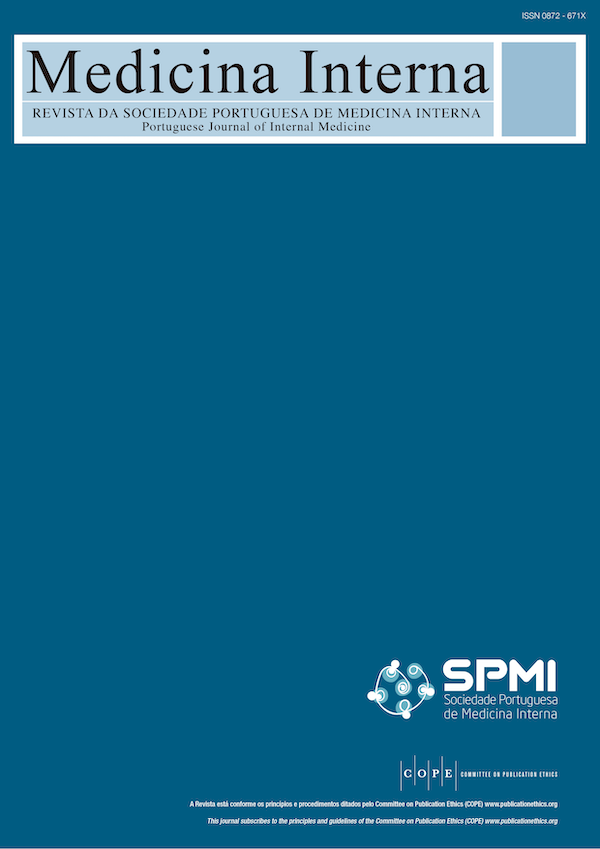Oxygen Therapy in Advanced Disease: Do You Know the Evidence?
DOI:
https://doi.org/10.24950/rspmi/Revisao/75/19/4/2019Keywords:
Oxygen Inhalation Therapy, Palliative CareAbstract
Dyspnoea is one of the most troublesome symptoms for
both patients with advanced disease and healthcare professionals. We still have a long path to run across, but there is
already plenty of information supporting that oxygen should
be carefully prescribed in end of life since as any other treatment there are side effects related to it and in many situations there seems to be no additional benefit on prescribing
this therapy. The present article constitutes a bibliographic
review of published data on this matter, being the main goal
of the authors to contribute to improve the treatment of end
of life patients.
Downloads
References
Parshall MB, Schwartzstein RM, Adams L, Banzett RB, Manning HL, Bourbeau J,et al. An official American Thoracic Society statement: Update on the mechanisms, assessment, and management of dyspnea. Am J Respir Crit Care Med. 2012;185:435–52. doi: 10.1164/rccm.201111- -2042ST.00
Solano JP, Gomes B, Higginson IJ. A comparison of symptom prevalence in far advanced cancer, aids, heart disease, chronic obstructive pulmonary disease, and renal disease. J Pain Symptom Manage. 2006;31:58–69.
Kamal AH,Maguire JM, Wheeler JL, Currow DC, Abernethy AP. 2012. Dyspnea review for the palliative care professional: treatment goals and therapeutic options. J Palliat Med. 2012; 15: 106–14. doi: 10.1089/ jpm.2011.0110
National Health Service – NHS. End of life care [accessed Jan 2019] Available from: https://www.nhs.uk/conditions/end-of-life-care/
Thomas W. LeBlanc, Amy P. Abernethy. Building the palliative care evidence base: lessons from a randomized controlled trial of oxygen vs. room air for refractory dyspnea. J Natl Compr Canc Netw. 2014; 12: 989–92.
Scott AA, Robinson CL, Thompson A, Oakes S, Bonwick H. Guidelines for the Use of Oxygen in Palliative Care; Cheshire and Merseyside Palliative and End of Life Care Strategic Clinical Network. [accessed Jan 2019] Available from: https://www.nwcscnsenate.nhs.uk/files/9814/5684/6563/ Oxygen_in_Palliative_Care_FINAL.pdf
Uronis HE, Currow DC, McCrory DC, Samsa GP, Abernethy AP. Oxygen for relief of dyspnoea in mildly- or non-hypoxaemic patients with cancer: a systematic review and meta-analysis. Br J Cancer. 2008;98:294-9. doi: 10.1038/sj.bjc.6604161.
Gippsland Region Palliative Care Consortium, Clinical Practice Group. Oxygen Use in Palliative Care Guideline and Flowchart: Policy No. GRPCC- -CPG004_1.0_2011.[accessed Jan 2019] Available from: http://www. grpcc.com.au/wp-content/uploads/2018/06/GRPCC-CPG0041.02016- -Oxygen-Use-Guideline-and-Flowchart.pdf
Abernethy AP, McDonald CF, Frith PA, Clark K, Herndon JE 2nd, Marcello J, et al. Effect of palliative oxygen versus room air in relief of breathlessness in patients with refractory dyspnoea: a double-blind, randomised controlled trial. Lancet. 2010;376:784-93. doi: 10.1016/S0140-6736(10)61115- 4.
Fardy HJ. Oxygen therapy in palliative care. NPJ Prim Care Respir Med. 2016;26:15073. doi: 10.1038/npjpcrm.2015.73.
Beasley R, Chien J, Douglas J, Eastlake L, Farah C, King G,et al. Thoracic Society of Australia and New Zealand oxygen guidelines for acute oxygen use in adults: 'Swimming between the flags'. Respirology. 2015;20:1182- 91. doi: 10.1111/resp.12620.
Campbell ML, Yarandi H, Dove-Medows E. Oxygen is nonbeneficial for most patients who are near death. J Pain Symptom Manage. 2013;45:517- 23. doi:10.1016/j.jpainsymman.2012.02.012.
Hodgkinson S, Ruegger J, Field-Smith A, Latchem S, Ahmedzai SH. Care of dying adults in the last days of life. Clin Med. 2016;16:254-8. doi:10.7861/clinmedicine.16-3-254.
O'Driscoll BR, Howard LS, Earis J, Mak V; British Thoracic Society Emergency Oxygen Guideline Group; BTS Emergency Oxygen Guideline Development Group. BTS guideline for oxygen use in adults in healthcare and emergency settings. Thorax. 2017;72:ii1-ii90. doi: 10.1136/thoraxjnl-2016-209729.
Clemens KE, Quednau I, Klaschik E. Use of oxygen and opioids in the palliation of dyspnoea in hypoxic and non-hypoxic palliative care patients: a prospective study. Support Care Cancer. 2009;17:367–77.
Ben-Aharon I, Gafter-Gvili A, Leibovici L, Stemmer SM. Interventions for alleviating cancer-related dyspnea: a systematic review and meta-analysis. Acta Oncol. 2012;51:996-1008. doi:10.3109/0284186X.2012.709638.
Ekström MP, Abernethy AP, Currow DC. The management of chronic breathlessness in patients with advanced and terminal illness. BMJ. 2015;350:g7617. doi:10.1136/bmj.g7617.
Levy MH, Back A, Bazargan S, Benedetti C, Billings JA, Block S, et al. Palliative care. Clinical practice guidelines in oncology. J Natl Compr Canc Netw. 2006;4:776-818.
Quinn-Lee L, Weggel J, Moch SD. Use of oxygen at the end of life: attitudes,beliefs, and practices in Wisconsin. WMJ. 2018;117:7-12.
Shah N, Mehta Z, Mehta Y. High-flow nasal cannula oxygen therapy in palliative care #330. J Palliat Med. 2017 ;20:679-80. doi: 10.1089/ jpm.2017.0108.
Tiep B, Carter R, Zachariah F, Williams AC, Horak D, Barnett M,et al. Oxygen for end-of-life lung cancer care: managing dyspnea and hypoxemia. Expert Rev Respir Med. 2013;7:479-90. doi: 10.1586/17476348.2013.816565.
Davidson PM, Johnson MJ. Update on the role of palliative oxygen. Curr Opin Support Palliat Care.2011;5:87-91. doi: 10.1097/ SPC.0b013e3283463cd3.
Kelly CA, O'Brien MR. Difficult decisions: An interpretative phenomenological analysis study of healthcare professionals' perceptions of oxygen therapy in palliative care. Palliat Med. 2015;29:950-8. doi:10.1177/0269216315584864.
Downloads
Published
How to Cite
Issue
Section
License

This work is licensed under a Creative Commons Attribution 4.0 International License.
Copyright (c) 2023 Medicina Interna






